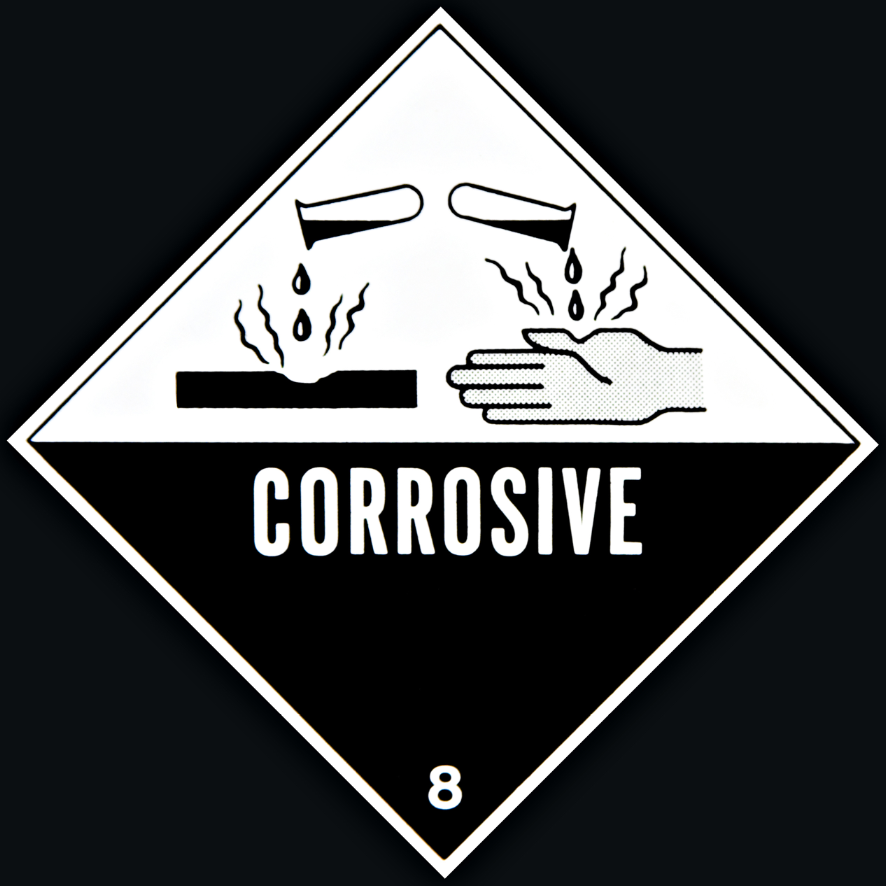Corrosives 101: A Guide to Identifying, Handling, and Storing Reactive Compounds
Corrosives have many exceptional industrial applications, including a role in metal etching and the plating industry. They can also be found in many cleaning agents. Similar to any other hazardous material, handling of corrosives requires extra precautions.
What are corrosives?
Corrosives are extremely reactive compounds that when introduced to living tissue — or other materials such as metal — can cause damage or destruction through chemical interactions at the site of contact. In general, corrosives can be classified as either acids or bases depending on where they fall on the
pH scale.
- Acids: Corrosive substances with a low pH (i.e., hydrochloric acid, sulfuric acid)
- Bases: Corrosive substances with a higher pH (i.e., sodium hydroxide, ammonia)
Additional chemicals, such as oxidizing and dehydrating agents, can also be classified as corrosives due to their chemical properties. A good rule of thumb to determine whether a material is classified as a corrosive is to reference its
Safety Data Sheet.
How can I be exposed?
Corrosives can come in all three forms of matter — solids, liquids, and gases — so exposure types vary. There are four routes of exposure by which corrosives can enter or interact with one’s body: inhalation, adsorption, ingestion and injection.
- Inhalation: Exposure to corrosives can occur through breathing in their fumes, vapors, gases, or particulate matter. Once inhaled internally, the respiratory tract can be damaged or irritated.
- Adsorption: Corrosive exposure can occur when one’s skin or soft tissues come in contact with a corrosive material. Corrosive solids in the form of a dust can quickly dissolve in the moisture on skin, liquids can splash onto exposed tissue, and gases can interact through skin contact.
- Ingestion: Ingestion occurs when a chemical or substance inadvertently finds its way to the mouth and is swallowed. Both corrosive solids and liquids can enter the body through ingestion exposure.
- Injection: Injection occurs when a chemical or substance enters the body through penetrated or punctured skin. All three states of matter can enter through this route. Once inside, immediate tissue can be damaged and the substance can further travel in the body through the blood stream.
How to handle corrosives
Before handling corrosives, ensure you are wearing the proper personal protective equipment (PPE), including chemical protective clothing, eye protection, and hand protection. The chemical protective clothing and gloves should be made of a chemical-resistant material that prevents corrosives from contacting the skin or permeating through the suit. Eye protection may vary from safety classes to safety goggles, but all options should have side shields and provide adequate protection from chemical splashes. If the PPE shows “wear or tear,” it should be replaced. Note that certain corrosives may require additional or specialized forms of protection such as a respirator, so it is important to review the
Safety Data Sheet for additional guidance.
Handling corrosives should be done conscientiously and carefully. When possible, corrosive chemicals should be transported with drum cradles or container caddies to avoid unnecessary contact with the material. If a damaged, degraded, or leaking container is identified, proper steps should be taken to prevent or address a
chemical spill.
How to store corrosives
When storing corrosives, all containers used must be resistant to corrosion such as plastic polyethylene drums or other properly-lined containers. Exceptions do apply in some cases where stainless steel or titanium containers can be used. The packaging type largely depends on the concentration of the material. Additionally, these containers should always remain sealed unless they are in use to prevent spills or release of vapors. At no time should corrosives be overstocked. It is best to only keep around what is necessary for the demands of your operation.
Another rule of thumb when storing corrosives is to isolate them in a dedicated area. This reduces the risk of an unwanted reaction caused by leaks or spills. When isolation cannot be done, it is important to store chemicals near compatible materials only. To identify compatible materials, reference the Segregation Table for Hazardous Materials in
49 CFR § 177.848. When storing corrosive materials, it is also important that all containers are correctly labeled with their appropriate hazard communication signs per regulations.
In addition to a dedicated area, corrosives are best kept in a well-ventilated environment to dissipate the buildup of any fumes. Certain corrosives may also require specific temperatures for safe storage. All flooring and shelving within the storage area should also be constructed out of corrosive-resistant materials. Small containers are best stored on compatible catch trays or storage cabinets. Large containers or tanks should be stored within a catch basin or surrounded by a dike. Sufficient spill kits should also be well kept in the area at all times.
Get help handling and disposing of corrosives
For more information on proper handling and disposal of corrosives, reach out to EnviroServe at
(800) 488-0910.

